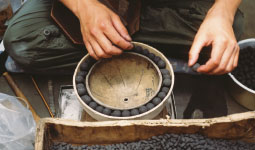Home > Highlighting JAPAN > Highlighting Japan August 2018 > How to Enjoy Summer in Japan
Highlighting JAPAN


Fire Flowers Light Up Japan’s Summers
Fireworks festivals are an essential element of summer in Japan, and the high level of Japanese pyrotechnic brilliance has brought them acclaim as works of art from overseas as well. Discover the origins and secrets to enjoying these bright and booming festivals.
Now an essential part of summer in Japan, fireworks reportedly came to prominence in 1733 during the Kyoho famine and a subsequent breakout of infectious diseases. The shogun at the time, Tokugawa Yoshimune, commissioned a large-scale fireworks display to dispel unclean influences and evil spirits during the opening of the Sumida River—a ceremony to celebrate the beginning of the cooler season, as well as a memorial for victims of water disasters and a time to pray for protection from such disasters—and the Suijin Festival, meant to appease the water god and ensure the availability of drinking water and water for farming.
Initially associated with funerals, fireworks eventually turned into a fixture at summer evening parties, including ceremonies and competitions. There are many ukiyo-e prints of people enjoying these pyrotechnics, showing how they became part of the Japanese cultural landscape.
The invention of the explosives used as raw material for fireworks dates back to China’s Qin dynasty (221-207 BC). Saltpeter was accidentally discovered around 200 BC, and in 1100 it was found that mixing it with sulfur and charcoal created “black explosives.” This new invention eventually crossed the Silk Road to reach Europe. In 1543, Portuguese adventurers who drifted to Tanegashima—a small island that is part of Kagoshima Prefecture—brought matchlock firearms to Japan, from where the culture of explosives became widespread.
“Explosives arrived as weapons during the Warring States period (1467-1603), but in the Edo period (1603-1867)—with the policy of isolation and hundreds of years of relative peace in Japan—while other countries used most of the knowledge about explosives to develop guns and cannons, Japan applied it to fireworks, which led to a dramatic improvement in techniques,” says Kazuma Saeki, a fireworks photographer with deep knowledge about the history and folk culture of the art. “It can be said that fireworks were a symbol of peace.”
Japanese fireworks are highly acclaimed as works of art around the world. They form beautiful, perfect circles when exploding, and can be up to several hundred meters across.
And while fireworks overseas are often just one color, Japanese fireworks can morph from blue to red or red to yellow. Fireworks called “stars” can both change color and form many layers surrounding the core. In addition, artisans attach flutes to the firework shells so that they make a whistling noise before they explode. Fireworks overseas are mostly machine-made, but in Japan they are typically handmade, which allows artisans to incorporate more detailed effects during the process.
Saeki’s advice on the best way to enjoy Japanese fireworks is to get to know the various types of fireworks. The two most common are the chrysanthemum—where the tail remains and the color changes after it explodes—and the peony, where the tail disappears and the color is the same from the core to the outer edges.
“Just being able to distinguish between these two will change the way you focus on and enjoy fireworks shows,” Saeki says.
The four basic firework colors are blue, red, yellow and green, but recently pastels and colors such as orange are also being developed. However, creating a new color takes exceptional effort, and mixing new, untested materials can even put a firework artisan’s life at risk. For that reason, it took the artisan who created emerald-green fireworks close to twenty years to develop them.
“I’d like viewers to avoid obsessing about filming the fireworks with smartphones and experience them through their own eyes, while fully appreciating the hard work of the artisans,” urges Saeki.
The best place to watch displays of these fire flowers is three to four hundred meters away from the launch pad, in an upwind position. This way you can keep your neck at a less tiring sixty-degree angle, and the smoke will not block your view. However, major fireworks shows tend to be very crowded, and it is difficult to secure an ideal spot.
“There are 8,500 fireworks shows in Japan each year, so if you search you will be able to find plenty of smaller-scale shows where you can enjoy the pyrotechnics without the crowds,” adds Saeki. He also suggested looking for “hidden spots” so that you can enjoy each firework set off, and deepen your enjoyment of summer in Japan.
© 2009 Cabinet Office, Government of Japan









